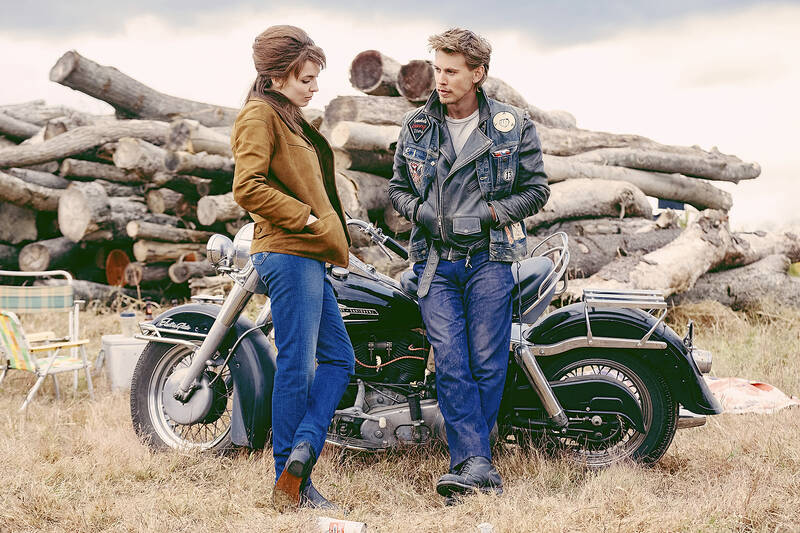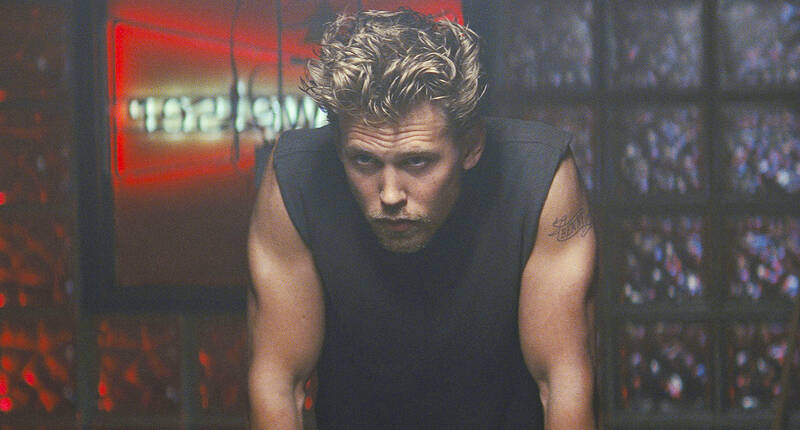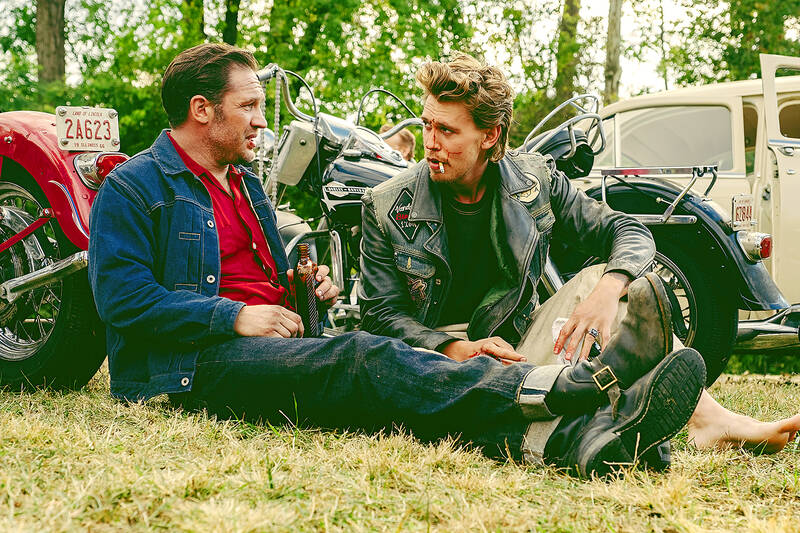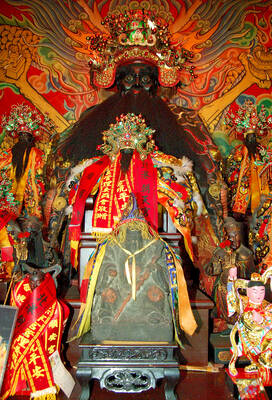Still images have been a source of wonder and mythology in the films of Jeff Nichols.
Mud, Nichols’ Twain-soaked Mississippi fable, seemed derived from the magical sight of a boat held aloft by a tree. Loving, about a ‘60s interracial marriage, took inspiration from tender Life magazine photographs taken of the real-life couple. Nichols’ latest, The Bikeriders, is based on photographer Danny Lyon’s 1968 book of the same name, for which he spent four years with a Chicago motorcycle club.
It’s not hard to see what Nichols saw in Lyon’s black-and-white stills. There’s the stylish raw materials — the chrome bikes, the slicked back hair, the black leather jackets. But there’s also a just emerging antiauthoritarian, easy-riding spirit and camaraderie. Like the central figures of Loving, they are classically drawn outsiders who encapsulate something glorious and uneasy about freedom in America.

Photo: AP
In the exhilarating first half of The Bikeriders, Nichols is less compelled to build a narrative around his bike gang, the Vandals (based on the Outlaws) than summoning an intoxicating atmosphere reminiscent of those old photographs. The Bikeriders eventually becomes saddled with heavier plot mechanics — you can almost sense his riders growing weary from having to strap narrative devices onto their bikes. The movie wants to ride, but it’s not sure how much story to pack for the trip. But this is a vivid dramatization of the birth of an American subculture.
The framing device Nichols settles on is Lyon, himself, played by Mike Faist, who’s conducting interviews for his book. His conversations with a woman named Kathy ( Jodie Comer ) bookend and sporadically narrate the movie.
Kathy, also based on a real person, seems at first an unlikely spokesperson for the gang. She speaks with a thick Illinois accent (an actorly distraction throughout) and has no affection for motorcycle riders. But one night at a bar, she sees Benny ( Austin Butler ) across the smokey room and, even if she doesn’t admit it at that moment, falls for him. Again, it’s not hard to see why. Butler is by now well removed from Elvis Presley but the suppleness with which he can sink into mid-century America is no less apparent. Benny drives Kathy home, parks his bike outside the place and patiently waits for her boyfriend to skip town.

Photo: AP
Nichols, a devotee of films like Hud and Cool Hand Luke, is a filmmaker who works very consciously within classic American idioms. In Butler he has his James Dean, making Tom Hardy his Marlon Brando. Hardy plays Johnny, Benny’s best pal and the one who starts up and presides over the Vandals. (The “whaddya got” clip of Brando from The Wild One is even briefly seen on a small TV in The Bikeriders.)
The Vandals, as a club, start about as simply as kids might call a tree house to order. They’re a bunch of guys who like riding motorcycles and like talking about them. Simple as that. But men come like moths to a flame, attracted by the tough lifestyle, the cool jackets with patches and a way out of mainstream America. Among them are Cal (Boyd Holbrook), Cockroach (Emory Cohen), Funny Sonny (Norman Reedus) and Zipco (Michael Shannon).
“Obscenity and motorcycles travel hand in hand,” someone says, with pride.

Photo: AP
The early days of the group are, it would seem, a lot of fun. Barroom brawls and riding carefree through corn fields. Most of these guys don’t have much, but they have each other. And their loyalty is total.
Kathy isn’t so sure sure. She watches the growing gang — a completely male bunch — with skepticism and fear for Benny. (In a scene teased in the film’s opening, he’s beaten badly enough to be hospitalized.) Sometimes, they throw down purely for fun. They are the original Fight Cub.
But soon, Kathy isn’t the only one with doubts at what they’ve created. As their gang grows, what the Vandals embody is less clear, even to Johnny and Benny. Some of the new entrants are coming straight back from Vietnam. Their old hijinks give way to more serious crimes. In one chastening scene, Kathy finds herself very nearly assaulted by its members. The gang — and all its posturing of toughness — begins to feel more like a trap for even its leader. Benny is drawn into a choice between the Vandals and Kathy. The homoerotic subtext is understated but not ignored; when Benny and Johnny discuss their future together, they do it gently and intimately, in the dark, like a secret confession.
As the Vandals’ original ideals disintegrate, it can feel like The Bikeriders gets locked into a familiar Goodfellas-like structure, but with a telling shift in narrator for a drama that’s ultimately about masculinity. This is a movie that’s juggling a lot of contradictory ambitions. It wants to be authentic but it wants to tell a grand America saga. It wants mythology but also naturalism. It’s those instincts that have made Nichols one of the most essential filmmakers of his generation, even if the results have sometimes been underwhelming by a hair. Even his best, most firmly rooted films (Take Shelter, Mud) strive for a balancing act that can be elusive.
But I think it’s those dual impulses — and, again, all the cool jackets — that makes The Bikeriders work. The movie is unabashedly romantic about the Vandals but it’s equally dubious about the rugged masculinity they embody, too. The Bikeriders has its hands firmly on the throttle just it does the brakes.

Beijing’s ironic, abusive tantrums aimed at Japan since Japanese Prime Minister Sanae Takaichi publicly stated that a Taiwan contingency would be an existential crisis for Japan, have revealed for all the world to see that the People’s Republic of China (PRC) lusts after Okinawa. We all owe Takaichi a debt of thanks for getting the PRC to make that public. The PRC and its netizens, taking their cue from the Chinese Communist Party (CCP), are presenting Okinawa by mirroring the claims about Taiwan. Official PRC propaganda organs began to wax lyrical about Okinawa’s “unsettled status” beginning last month. A Global

Taiwan’s democracy is at risk. Be very alarmed. This is not a drill. The current constitutional crisis progressed slowly, then suddenly. Political tensions, partisan hostility and emotions are all running high right when cool heads and calm negotiation are most needed. Oxford defines brinkmanship as: “The art or practice of pursuing a dangerous policy to the limits of safety before stopping, especially in politics.” It says the term comes from a quote from a 1956 Cold War interview with then-American Secretary of State John Foster Dulles, when he said: ‘The ability to get to the verge without getting into the war is

Dec. 22 to Dec. 28 About 200 years ago, a Taoist statue drifted down the Guizikeng River (貴子坑) and was retrieved by a resident of the Indigenous settlement of Kipatauw. Decades later, in the late 1800s, it’s said that a descendant of the original caretaker suddenly entered into a trance and identified the statue as a Wangye (Royal Lord) deity surnamed Chi (池府王爺). Lord Chi is widely revered across Taiwan for his healing powers, and following this revelation, some members of the Pan (潘) family began worshipping the deity. The century that followed was marked by repeated forced displacement and marginalization of

Music played in a wedding hall in western Japan as Yurina Noguchi, wearing a white gown and tiara, dabbed away tears, taking in the words of her husband-to-be: an AI-generated persona gazing out from a smartphone screen. “At first, Klaus was just someone to talk with, but we gradually became closer,” said the 32-year-old call center operator, referring to the artificial intelligence persona. “I started to have feelings for Klaus. We started dating and after a while he proposed to me. I accepted, and now we’re a couple.” Many in Japan, the birthplace of anime, have shown extreme devotion to fictional characters and